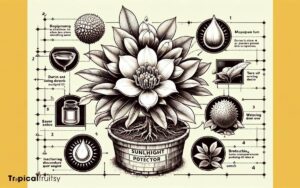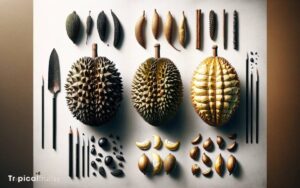How Much Is Durian in Malaysia? Exploring Prices!
The cost of durian in Malaysia ranges based on variety, seasonality, and location. Premium varieties like Musang King are priced higher, often varying between RM30 to RM100 per kilogram, depending on the season and region.
The durian season, typically from June to August, may offer more competitive pricing.
Additionally, prices may be lower in rural areas where durians are grown compared to urban markets.
The price of durian in Malaysia is influenced by:
Experience the luscious taste of Malaysian durians, with prices reflecting the variety, harvest season, and market location.
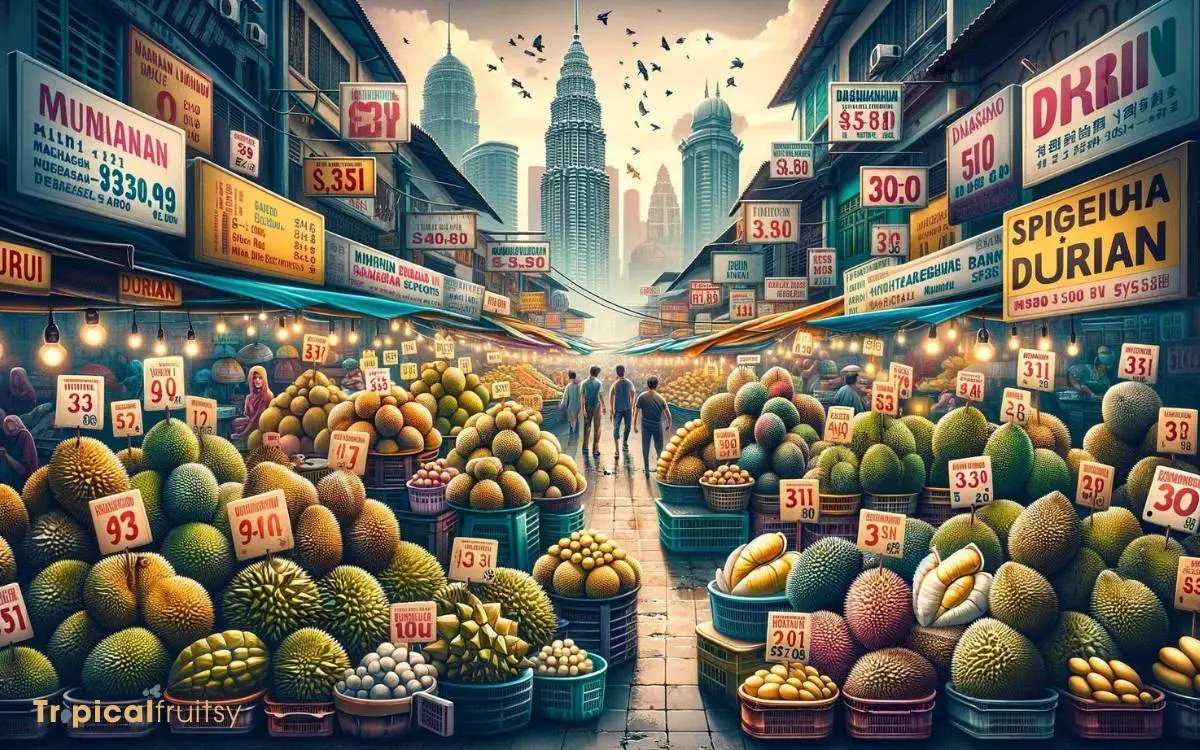
Key Takeaway
Durian Price Guide in Malaysia: Varieties and Seasonal Rates
| Variety | Off-Season Price (per kg) | Peak Season Price (per kg) | Typical Location Price Variation |
|---|---|---|---|
| Musang King | RM60 – RM100 | RM30 – RM60 | Higher in urban areas |
| D24 | RM25 – RM50 | RM15 – RM30 | Higher in urban areas |
| Red Prawn | RM30 – RM60 | RM20 – RM40 | Higher in urban areas |
| Regular Varieties | RM15 – RM30 | RM10 – RM20 | Lower in rural areas |
Understanding Durian Varieties
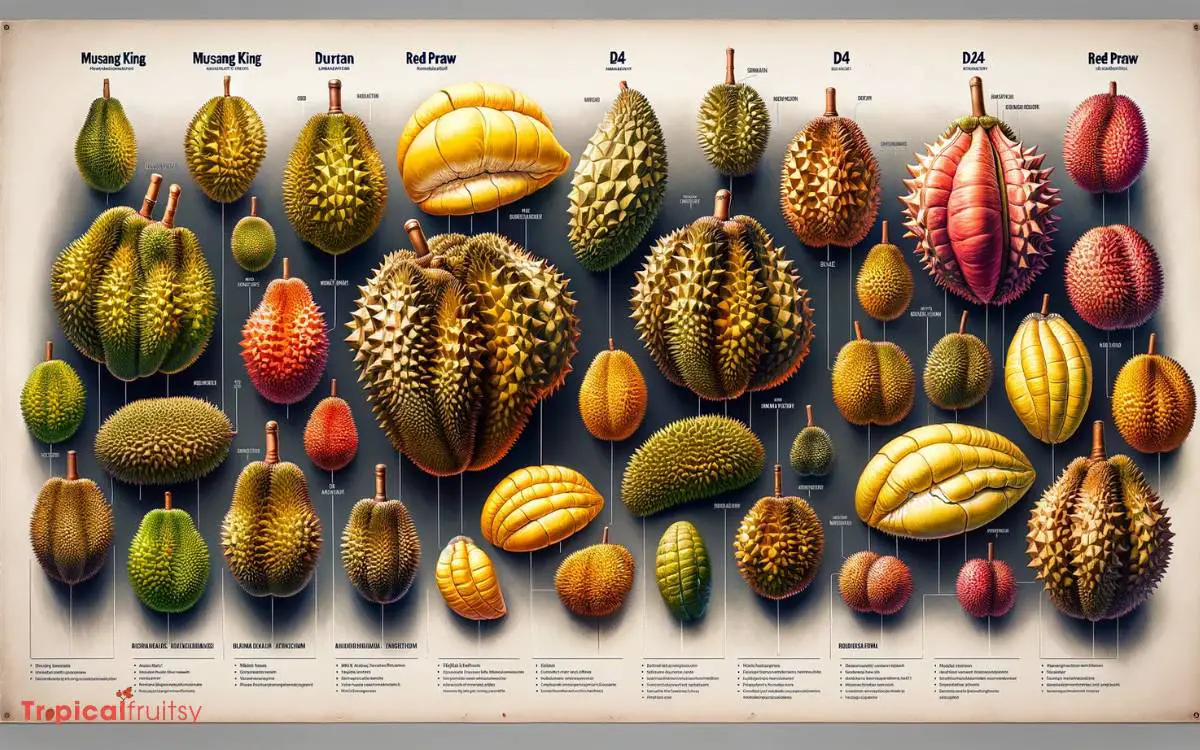
The price of durian in Malaysia is significantly influenced by the variety of the fruit, each of which possesses distinct characteristics and market value.
Premium types such as Musang King are highly sought after for their creamy texture and robust flavor, often fetching prices over RM50 per kilogram.
In contrast, more common varieties like D24 may be priced around RM25 per kilogram, reflecting a lower market demand.
Data from agricultural markets show a clear correlation between the scarcity of specific durian breeds and their pricing structures. Analyzing these trends, buyers and sellers alike can predict pricing variations.
Furthermore, meticulous genetic selection and cultivation practices can lead to increased cost due to the extensive care required.
Seasonal Price Fluctuations

Durian prices in Malaysia exhibit significant variance in response to seasonal changes. Peak season trends typically reflect an increased supply, which correlates with lower market prices.
During off-peak periods, scarcity of the fruit can drive prices upward. This scarcity can press consumers to pay a premium for durians outside their main harvesting window.
An analysis of historical price data can help elucidate the patterns of price fluctuations. It can also provide consumers with expectations for future purchasing periods.
Peak Season Trends
During the peak season in Malaysia, typically spanning from June to August, durian prices can experience significant fluctuations based on factors such as harvest quality, demand, and regional availability.
- Anticipation of tasting the rich, creamy flesh of a freshly opened durian ignites joy in enthusiasts.
- Disappointment creeps in when poor weather conditions reduce crop yield, elevating prices.
- The surge in demand from both local and international markets can lead to a spirited yet anxious race to secure the season’s best.
- Fleeting availability of coveted varieties such as Musang King stirs a sense of urgency and desire among aficionados.
Analyzing the data, it’s evident that these fluctuations are driven by tangible metrics that impact both the emotional and economic landscape of durian consumption in Malaysia.
Off-Season Costs
Off-season price hikes in durian fruit often reflect the scarcity of supply outside the June to August peak period in Malaysia.
Data indicates a substantial increase in durian prices during the off-season, with variations depending on the variety and region.
For instance, the sought-after Musang King may see prices doubling, sometimes even tripling, compared to peak season rates.
An analytical review of market trends shows that average off-season costs can surge by 50% to 100%, as durians become a limited commodity. These fluctuations are driven by several factors, including lower yield and increased logistical expenses.
Precision in pricing is also affected by import demands, particularly from neighboring countries, which intensify competition for the available stock, pushing prices upward.
Consumers desiring durian outside the typical season must prepare for these heightened expenses.
Regional Cost Differences
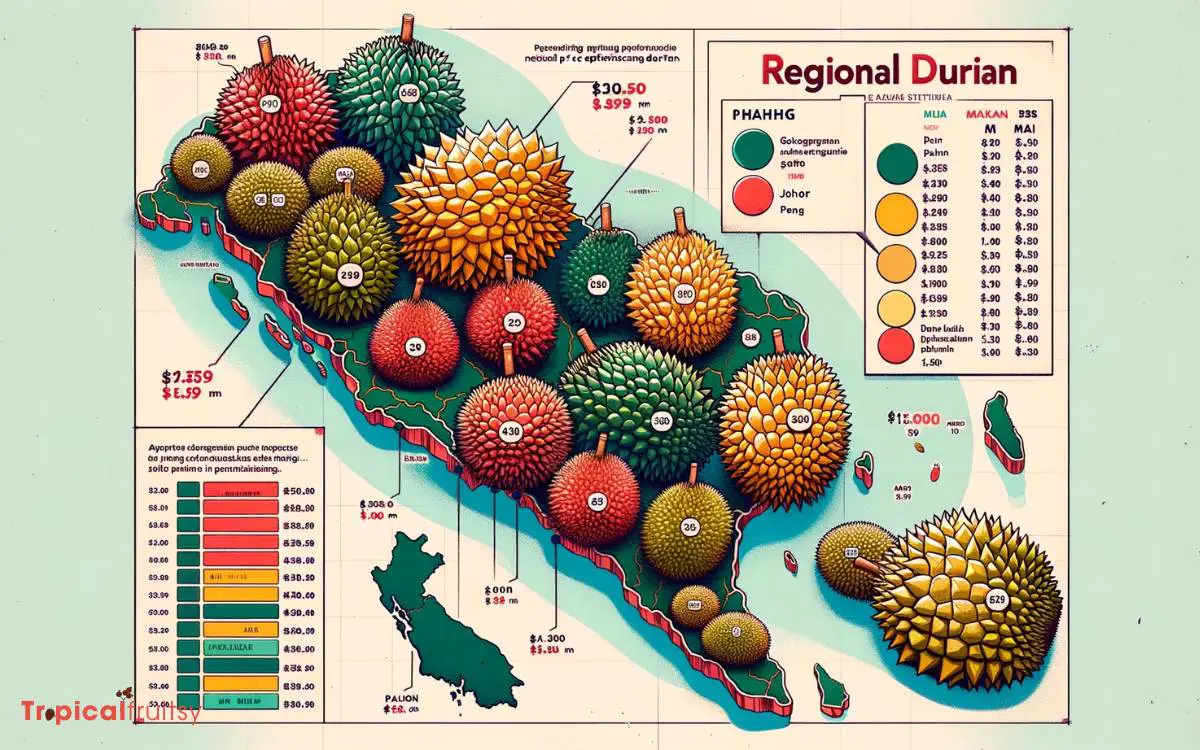
Why do durian prices vary significantly across different regions in Malaysia? The answer lies within a matrix of factors that influence agricultural commerce on a regional scale.
A precise analysis of the market delineates several key elements:
- Proximity to Durian Farms: Regions closer to durian orchards often enjoy lower prices due to reduced transportation costs.
- Local Demand: Areas with a higher appetite for durian may experience increased prices because of the willingness to pay a premium for this coveted fruit.
- Economic Status: Affluent regions might exhibit higher durian prices, reflecting the purchasing power of its residents.
- Seasonal Production Variations: Different regions encounter varying peak seasons, which can affect availability and pricing.
Understanding these factors provides a comprehensive picture of the fluctuating durian costs across Malaysia.
Factors Affecting Durian Prices
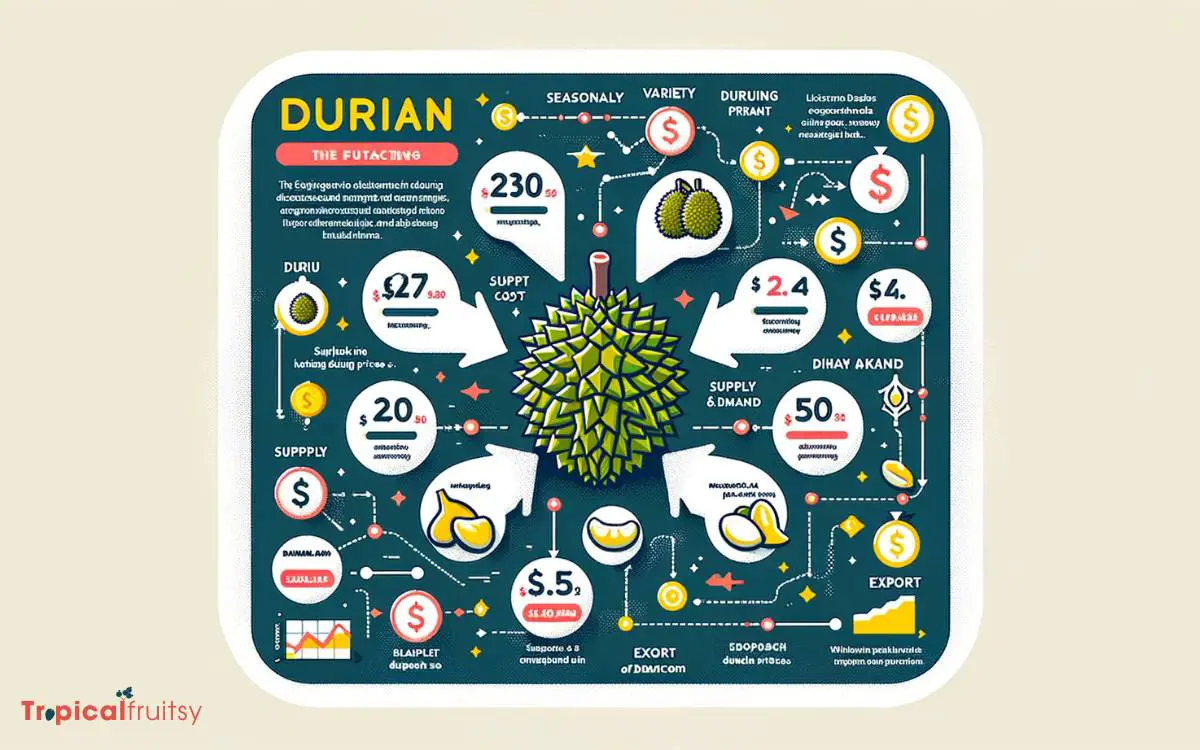
The price of durian in Malaysia is influenced by a variety of factors, including seasonal yield fluctuations, export demand, and agricultural challenges.
These determinants are crucial for understanding the market dynamics and price trends of this sought-after fruit.
The following table summarizes the key factors that affect durian prices:
| Factor | Description | Impact on Price |
|---|---|---|
| Seasonal Yield | Varies with weather conditions and farming practices. | High yield typically lowers prices. |
| Export Demand | Driven by international markets, primarily China. | Increased demand leads to higher prices. |
| Agricultural Challenges | Include pests, diseases, and labor shortages. | Adverse effects can increase prices due to lower supply. |
A data-driven analysis reveals that these factors interplay to shape the cost of durian, reflecting the complexity of agricultural economics and global trade influences.
Tips for Buying Durian

Although durian prices in Malaysia can fluctuate, consumers can employ strategic purchasing practices to secure the best value for their money.
By analyzing market trends and applying a few smart buying tips, one can enhance the durian purchasing experience while also ensuring quality and affordability.
Consider the following:
- Buy in season to ensure freshness and lower prices.
- Purchase from reputable sellers with a track record for quality.
- Consider buying in bulk if storage and consumption rates permit.
- Be aware of grades and cultivar types to match price with desired quality.
These data-driven strategies are not only cost-effective but also heighten the emotional gratification of savoring high-quality durian at a reasonable price.
Average Durian Prices in Malaysia
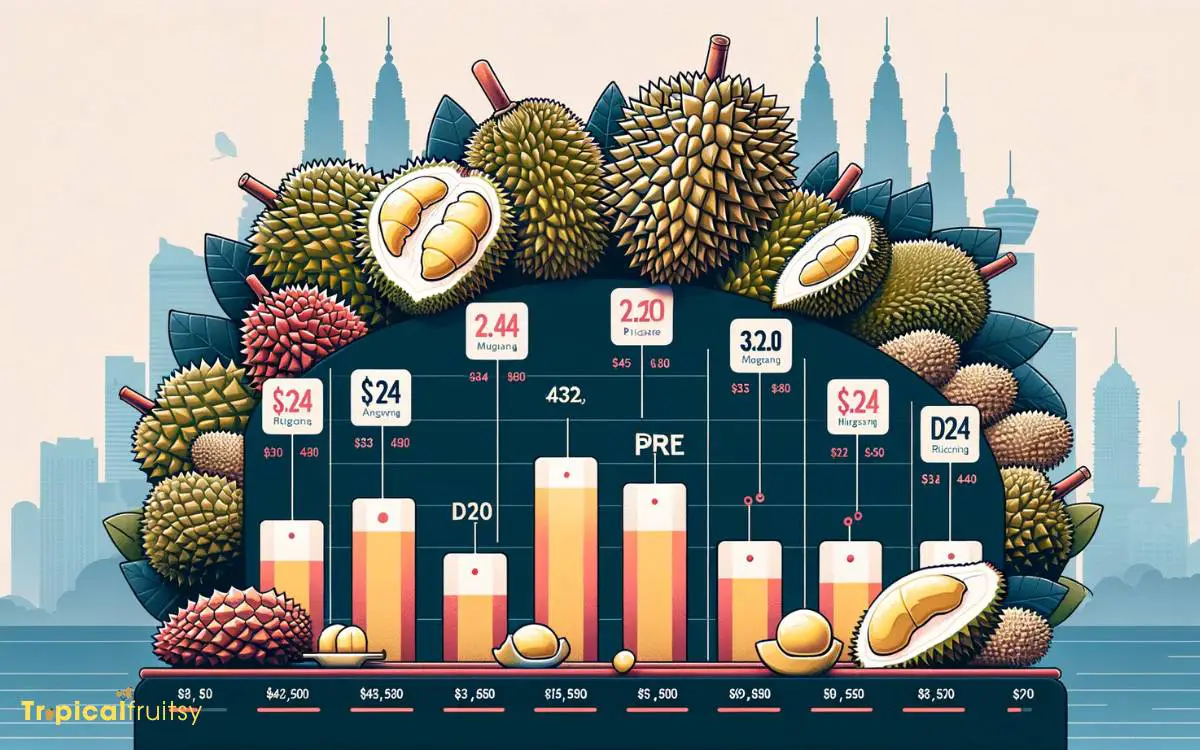
Durian prices in Malaysia typically vary by season, region, and variety, with average costs ranging from MYR 15 to MYR 50 per kilogram.
The fluctuations in pricing are influenced by a multitude of factors including climatic conditions, demand, and the fruit’s maturity.
To provide an analytical perspective, the following table delineates the average price range for popular durian varieties across different regions in Malaysia.
| Variety | Region | Average Price (MYR/kg) |
|---|---|---|
| Musang King | Pahang | 35 – 50 |
| D24 Sultan | Johor | 20 – 30 |
| Red Prawn | Penang | 25 – 40 |
| Hor Lor | Perak | 15 – 25 |
These figures illustrate the premium commanded by highly sought-after varieties such as Musang King, especially in durian-producing regions where quality is perceived to be higher.
Conclusion
The multifaceted pricing of durian in Malaysia is shaped by an intricate interplay of variety, seasonality, geography, and market dynamics.
While the Musang King reigns supreme in price, temporal and regional variances underscore the complexity of the durian market.
Consumers must navigate these layers to ascertain value. Empirical data suggests that judicious purchasing decisions hinge upon a comprehensive understanding of these factors, ultimately influencing the average price spectrum across Malaysia.

